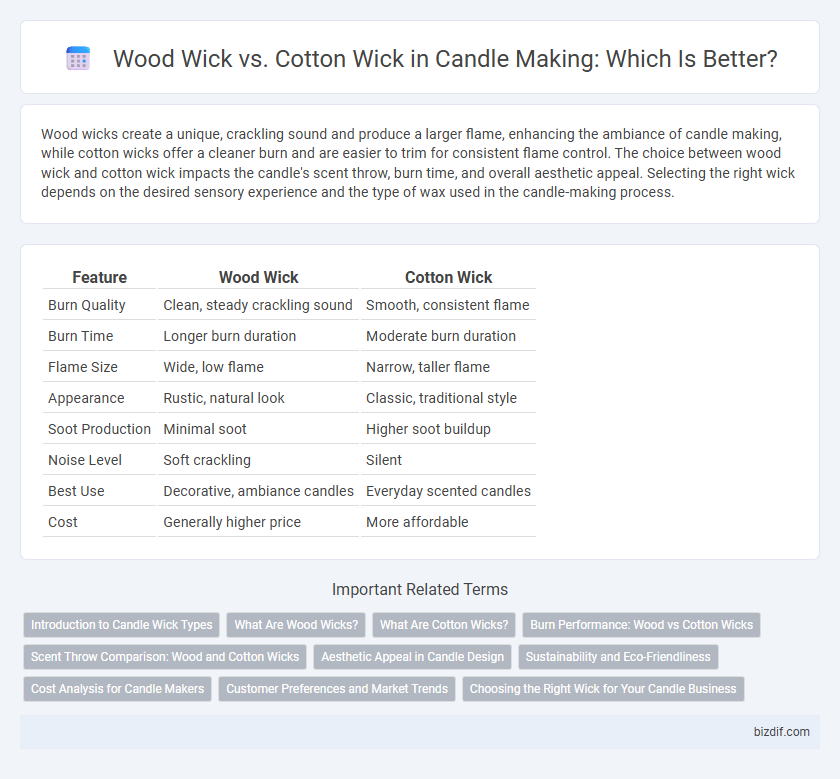Wood wicks create a unique, crackling sound and produce a larger flame, enhancing the ambiance of candle making, while cotton wicks offer a cleaner burn and are easier to trim for consistent flame control. The choice between wood wick and cotton wick impacts the candle's scent throw, burn time, and overall aesthetic appeal. Selecting the right wick depends on the desired sensory experience and the type of wax used in the candle-making process.
Table of Comparison
| Feature | Wood Wick | Cotton Wick |
|---|---|---|
| Burn Quality | Clean, steady crackling sound | Smooth, consistent flame |
| Burn Time | Longer burn duration | Moderate burn duration |
| Flame Size | Wide, low flame | Narrow, taller flame |
| Appearance | Rustic, natural look | Classic, traditional style |
| Soot Production | Minimal soot | Higher soot buildup |
| Noise Level | Soft crackling | Silent |
| Best Use | Decorative, ambiance candles | Everyday scented candles |
| Cost | Generally higher price | More affordable |
Introduction to Candle Wick Types
Wood wicks provide a clean, crackling burn that enhances the sensory experience of candle making, while cotton wicks offer a consistent and steady flame ideal for various candle types. Choosing between wood and cotton wicks depends on factors such as wax compatibility, burn time, and desired aesthetic. Both wick types play a crucial role in optimizing fragrance throw and ensuring an even melt pool.
What Are Wood Wicks?
Wood wicks are flat, thin strips of wood used as candle wicks that create a unique crackling sound when burning, enhancing the sensory experience of candle making. They provide a cleaner, longer-lasting burn compared to traditional cotton wicks and produce a wider flame, which helps distribute fragrance more effectively. Wood wicks are typically made from sustainable hardwoods like cherry or maple, making them an eco-friendly option for artisanal candles.
What Are Cotton Wicks?
Cotton wicks are made from braided or twisted cotton fibers, providing a clean and steady flame ideal for various candle types. They burn evenly with minimal soot, enhancing the overall safety and aesthetic of candles. Cotton wicks are preferred for soy candles and other natural waxes due to their eco-friendly, chemical-free composition.
Burn Performance: Wood vs Cotton Wicks
Wood wicks offer a steady, crackling burn that enhances ambiance and produces a wider flame, which helps distribute fragrance more evenly in candles. Cotton wicks provide a cleaner burn with less smoke and are more versatile, suitable for various wax types and scents. Compared to cotton, wood wicks generally require more precise trimming and wax formulation to maintain optimal performance and prevent tunneling.
Scent Throw Comparison: Wood and Cotton Wicks
Wood wicks provide a subtle, even burn that tends to enhance the natural scent throw of woodsy and earthy fragrance oils, creating a warm ambiance. Cotton wicks typically deliver a stronger scent throw with floral and fruity scents due to their consistent, higher flame temperature. Choosing between wood and cotton wicks depends on the candle's fragrance profile and desired scent intensity.
Aesthetic Appeal in Candle Design
Wood wicks offer a unique, crackling flame that enhances the visual and sensory appeal of candles, creating a warm and rustic ambiance. Cotton wicks provide a classic, steady flame with clean lines, complementing traditional candle designs with elegance. Choosing between wood and cotton wicks significantly influences the candle's aesthetic appeal and the overall atmosphere it creates.
Sustainability and Eco-Friendliness
Wood wicks offer greater sustainability by using natural, renewable wood sources that reduce reliance on processed fibers, while cotton wicks often require agricultural chemicals and extensive water use. Eco-friendly wood wicks create less smoke and burn more cleanly, minimizing indoor air pollution compared to typical cotton wicks. Choosing sustainably harvested wood wicks supports responsible forestry practices and lowers the carbon footprint of candle production.
Cost Analysis for Candle Makers
Wood wicks typically cost more than cotton wicks due to their natural sourcing and manufacturing complexity, impacting overall candle production expenses. Cotton wicks are more economical and widely available, making them a preferred choice for budget-conscious candle makers. However, wood wicks offer a unique aesthetic and crackling sound that can justify their premium price in artisanal or luxury candle lines.
Customer Preferences and Market Trends
Wood wicks, known for their crackling sound and even burn, have gained popularity among customers seeking a rustic and sensory candle experience, while cotton wicks remain preferred for their traditional flame and versatility with various wax types. Market trends indicate a growing demand for sustainable and unique candle features, driving increased interest in wood wick products. Consumer preferences reveal that eco-conscious buyers prioritize natural materials and aesthetic appeal, influencing manufacturers to expand wood wick offerings alongside conventional cotton wick candles.
Choosing the Right Wick for Your Candle Business
Selecting the right wick is crucial for candle making success, with wood wicks offering a unique crackling sound and a cleaner, even burn, while cotton wicks provide a traditional flame with consistent heat distribution ideal for various wax types. Wood wicks tend to enhance the aesthetic appeal and are favored for soy and beeswax candles, whereas cotton wicks are versatile and cost-effective, making them suitable for both paraffin and natural wax blends. Understanding the burn characteristics and customer preferences helps candle businesses optimize fragrance throw, burn time, and overall product quality.
Wood wick vs Cotton wick Infographic

 bizdif.com
bizdif.com